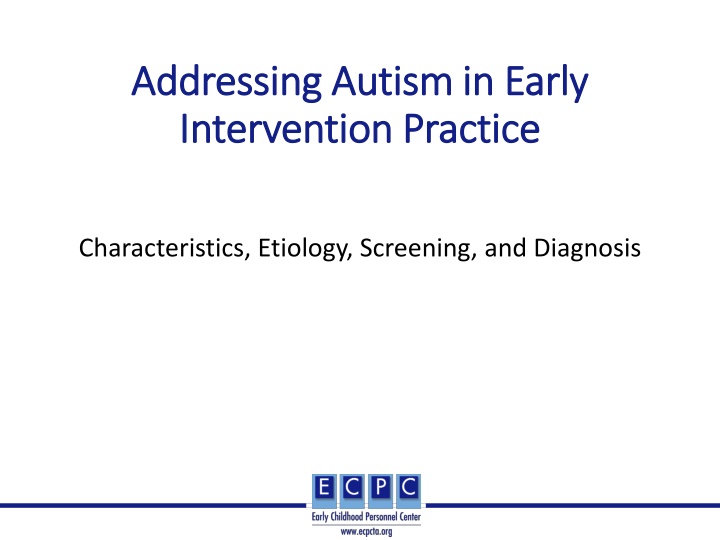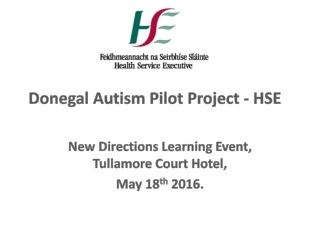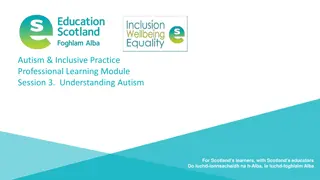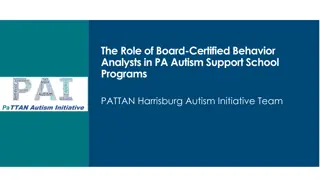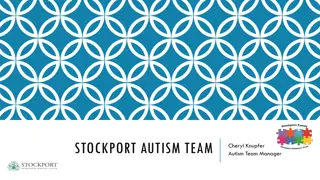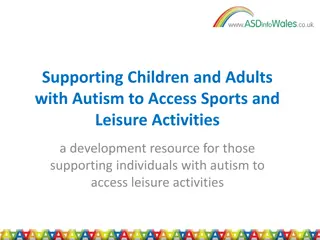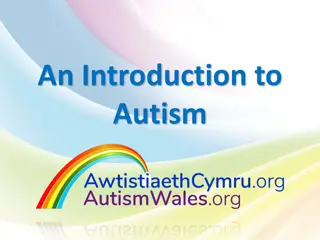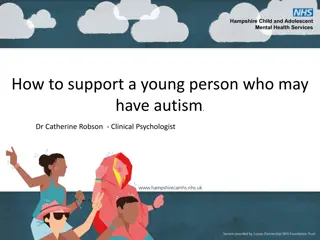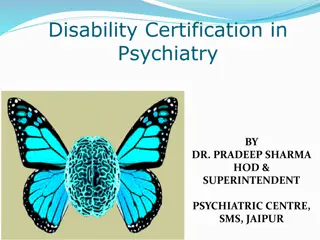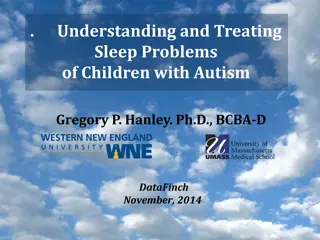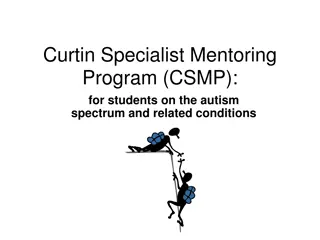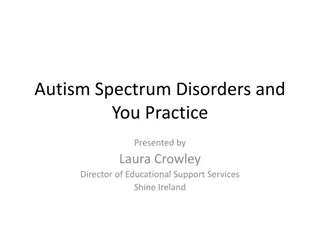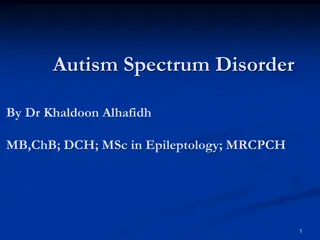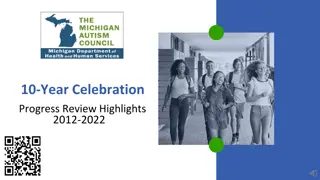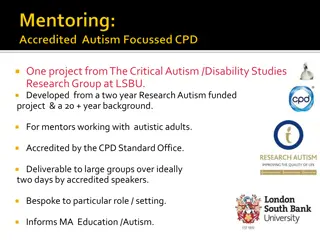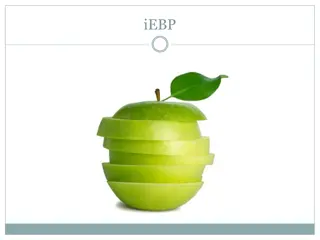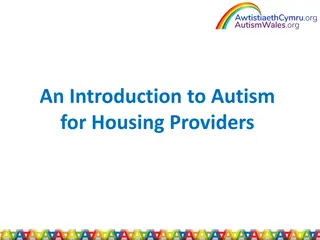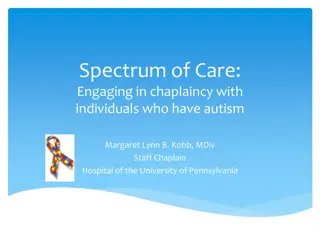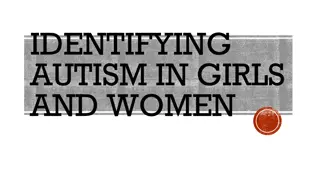Addressing Autism in Early Intervention Practice: Characteristics, Etiology, Screening
Autism Spectrum Disorder (ASD) is a neurodevelopmental disorder with early signs identifiable in young children. This resource covers the importance of early identification, screening strategies, diagnostic evaluation, and common signs of autism. Explore the modules designed for professionals to enhance understanding and intervention practices for children with ASD.
Download Presentation

Please find below an Image/Link to download the presentation.
The content on the website is provided AS IS for your information and personal use only. It may not be sold, licensed, or shared on other websites without obtaining consent from the author.If you encounter any issues during the download, it is possible that the publisher has removed the file from their server.
You are allowed to download the files provided on this website for personal or commercial use, subject to the condition that they are used lawfully. All files are the property of their respective owners.
The content on the website is provided AS IS for your information and personal use only. It may not be sold, licensed, or shared on other websites without obtaining consent from the author.
E N D
Presentation Transcript
Addressing Autism in Early Addressing Autism in Early Intervention Practice Intervention Practice Characteristics, Etiology, Screening, and Diagnosis
Autism Modules 1 and 2: Introduction Autism Modules 1 and 2: Introduction This resource, consisting of 2 modules, is designed to provide EI/ECSE professionals with a functional understanding of autism spectrum disorder (ASD) in young children, how to support early identification, diagnosis, and referral to services, and to review effective, evidence- based interventions designed for use with this population. Before you get started with this module, please create a sign-in name and password at Autism Navigator Resources: https://resources.autismnavigator.com/. After you sign in, you will have access to each of the video activities you will complete over the course of the Module.
Overview: Module 1 Overview: Module 1 Given that Autism Spectrum Disorder (ASD) emerges from birth and is identifiable in the first years of life, it is critically important that families and professionals alike are prepared to recognize the early signs of ASD and identify the criteria for an ASD diagnosis. Identification is the first step towards ensuring that children at-risk for or who have ASD have access to evidence-based services designed for young children in the context of natural caregiving routines - to optimize life-long developmental trajectories.
Objectives Objectives Describe the characteristics, prevalence, and etiology of Autism Spectrum Disorder (ASD) Describe the importance of early identification for children with ASD List specific strategies used to screen young children for autism risk List common signs of early autism and what they look like in the context of observation and assessment List the components of a diagnostic evaluation for ASD Describe diagnostic tools commonly used with young children at-risk for or who have ASD
What is Autism Spectrum What is Autism Spectrum Disorder? Disorder? Autism is one word attempting to describe millions of different stories Stuart Duncan, creator of Autism from a Father s Point of View
Autism Spectrum Disorder (ASD) Autism Spectrum Disorder (ASD) A neurodevelopmental disorder that emerges from the time of birth Different for every individual
Characteristics of Autism Characteristics of Autism Decreased social interaction and social communication Restricted and repetitive interests and activities Sensory differences Affects all ethnic and socioeconomic groups 31% of children with ASD have an intellectual disability (Maenner et al., 2020)
Prevalence of ASD Prevalence of ASD From the Centers for Disease Control (2021): https://www.cdc.gov/ncbddd/autism/data.html 1 in 44 Children in the US 1 in 27 boys - 1 in 116 girls Boys 4 times more likely to be diagnosed Girls may be more likely to camouflage resulting in under identification (Dean, M., Harwood, R., & Kasari, C., 2017)
Impact Impact The severity of ASD is determined by the degree to which differences in social interaction and communication and/or restricted/repetitive interests impact a child s ability to participate in daily life (Bauminger-Zviely et al., 2014)
Associated Challenges Associated Challenges ~40% of people with ASD are preverbal/nonverbal Nearly half of people with ASD wander or bolt from safety 28% of children with ASD have self-injurious behaviors like head banging, arm biting, skin scratching Nearly 2/3 of children with ASD between the ages of 6 and 15 have been bullied
Associated Conditions Associated Conditions Children with ASD are more likely to: Also have Attention Deficit Hyperactivity Disorder (ADHD) Be affected by anxiety disorders and depression Have chronic gastrointestinal disorders Have chronic sleep problems Have epilepsy
Associated Strengths Associated Strengths Children of all abilities have strengths! Strengths not necessarily dependent on verbal ability, IQ scores, social skills Among a wide range of individual strengths, some people with ASD may also have enhanced visual and auditory perception and pattern detection abilities (e.g., Mottron et al., 2009) Adults with ASD have reported increased ability to focus, attend to detail, remember facts, experiences or conversations (e.g., Russell et al., 2019) Other shared strengths have yet to be fully researched for example: increased likelihood of engagement in moral decision-making/honesty (e.g., Hu et al., 2020), reliability, loyalty.
Video Activity Video Activity Watch this video: Amazing Things Happen (4 min) Identify one way this video supported your understanding of autism Identify one way this perspective informs your approach to serving young children with autism and their families
ASD: A Complex Etiology ASD: A Complex Etiology Not caused by vaccines! (Anders et al., 2019) Genetically mediated Influenced by environmental factors Involving both genetic and environmental factors, ASD is a consequence of cascading developmental events from the beginning of life, beginning with decreased attention to faces and social stimuli
Identification of ASD Identification of ASD Diagnosis now possible in the first year of life Three patterns of onset Evident from birth Regression pattern Plateau (Klin, Lin, Gorrindo et al., 2009; Ozonoff & Iosif., 2019)
Causes and Risk Factors Causes and Risk Factors Children with a sibling with ASD are at higher risk Certain genetic conditions are associated with ASD like fragile x syndrome or tuberous sclerosis Emerging evidence suggest that a critical period for the development of ASD occurs in the period just before, during, and immediately after birth Children born to older parents are also at greater risk
Identification of ASD Identification of ASD Parents are sensitive observers and can provide accurate reports about emerging/regressing patterns of development in the first years of life (e.g., Ozonoff et al., 2018b) Average age of diagnosis is still just over 4 years of age (Baio et al., 2018) Children from low-income families are diagnosed even later (Christensen et al., 2016)
Activity Activity Ami Klin Ted Talk Ami Klin Ted Talk Watch this video of Dr. Ami Klin talking about autism Why does he say early diagnosis is so important? What does he mean when he says, autism creates itself ? How does his message about the importance of identification in the first years of life inform your professional practice?
Ami Klin Video Ami Klin Video
Early Intervention is Effective Early Intervention is Effective A growing body of research demonstrates that early intervention designed to enhance early interactions in the first years of life can mitigate impact of the cascading developmental changes if ASD, even reducing the odds of an ASD diagnosis (e.g., Whitehouse et al., 2021)
ASD Screening ASD Screening American Academy of Pediatrics recommends screening at well-child visits at 18 and 24 months using the M-CHAT and M-CHAT with Follow-Up Successfully increased numbers of children being identified in the first 3 years of life CDC and Learn the Signs. Act Early program has also improved rates of autism identification through national efforts to promote developmental monitoring Autism-specific surveillance resources like Baby Navigator are also available More work needed to broaden scope and effectiveness of autism screening and timely referral to diagnostic services for minoritized populations ~Half of all screen-positive children may never access diagnostic services (Daniels et al., 2014)
Early signs of Autism Early signs of Autism
Unusual Visual Fixations Unusual Visual Fixations Strong focus on details of objects or sensory phenomenon
Atypical Repetitive Behaviors Atypical Repetitive Behaviors Persistently repeating an action
Delayed Age Delayed Age- -Appropriate Sounds Appropriate Sounds Delayed development of babbling
Delayed Non Delayed Non- -Verbal Communication Verbal Communication Neutral facial expressions Reduced efforts to gain the attention of another Reduced use of gestures to share attention
Decreased Attention to Faces Decreased Attention to Faces More interested in objects than people Difficult to sustain face-to-face interactions
Differing Developmental Trajectories Differing Developmental Trajectories Acquiring expertise about the social world Acquiring expertise about the physical world Adapted from Ami Klin, 2015
ASD: From Screening to Diagnosis ASD: From Screening to Diagnosis There are no medical tests for diagnosing autism When parents become concerned about developmental delays in children, they should consult a physician and request an EI evaluation, which is available at no cost in all states (Bauminger-Zviely et al., 2014)
Six Components of a Diagnostic Six Components of a Diagnostic Evaluation for Autism Evaluation for Autism Best practice guidelines identify the following six components: Parent or caregiver interview Review of relevant medical, psychological, and/or school records Cognitive/developmental assessment Direct play observation Measurement of adaptive functioning Comprehensive medical examination
ASD Diagnostic Criteria ASD Diagnostic Criteria ASD diagnostic criteria are described by the American Psychiatric Association (APA) in its Diagnostic & Statistical Manual of Mental Disorders (DSM-V) Activity: Explore the DSM diagnostic criteria here at the Autism Speaks website
ASD Specification of Severity ASD Specification of Severity Qualified professionals use information gathered during the diagnostic assessment to indicate the level of support an individual with ASD requires: Level 1 Requiring Support Level 2 Requiring Substantial Support Level 3 Requiring Very Substantial Support.
DSM DSM- -V ASD Diagnostic Criteria: V ASD Diagnostic Criteria: Communication Area Communication Area Definition: Persistent reductions in social communication and social interaction across multiple contexts including: Social-emotional reciprocity Nonverbal communicative behaviors used for social interaction Developing, maintaining, and understanding relationships (APA., 2013)
Activity: Video Observation of Activity: Video Observation of Social Communication Differences Social Communication Differences Autism Navigator Social-Emotional Reciprocity Initiating or Responding to Social Interaction
DSM DSM- -V ASD Diagnostic Criteria: V ASD Diagnostic Criteria: Restricted/Repetitive Patterns Restricted/Repetitive Patterns Restricted, repetitive patterns of behavior, interests, or activities: Stereotyped or repetitive motor movements, use of objects, or speech Insistence on sameness, inflexible adherence to routines, or ritualized patterns of verbal or nonverbal behavior Highly restricted, fixated interests that are abnormal in intensity or focus (APA., 2013)
Activity: Observation of Activity: Observation of Restricted/Repetitive Patterns Restricted/Repetitive Patterns Autism Navigator Repetitive Behaviors and Restricted Interests Repetitive Movements Preoccupation with Unusual Objects
Sensory Differences Sensory Differences Hyper- or hypo-reactivity to sensory input or unusual interest in sensory aspects of the environment Children may show sensory defensiveness to some kinds of sensory input, yet may appear not to register other forms of sensory stimuli May show a high tolerance for pain
Unusual Sensory Input or Interest Unusual Sensory Input or Interest Autism Navigator Unusual Sensory Input or Interest Over Reactive Under Reactive
Uneven Development of Skills Uneven Development of Skills May demonstrate good problem-solving capacities and constructive play skills despite a lag in expressive and receptive language skills Social communication skills that have been developing typically may begin to fade during the second year Autism Navigator Associated Features: Uneven Development of Skills
Some Common Diagnostic Measures Some Common Diagnostic Measures Autism Diagnosis Interview Revised (ADI-R) Autism Diagnostic Observation Schedule, Second Edition (ADOS-2) Childhood Autism Rating Scale (CARS) Skill Based Developmental Measures Speech, Language & Social Communication Assessment
Autism Diagnosis Interview Autism Diagnosis Interview Revised (ADI Revised (ADI- -R) R) A clinical diagnostic instrument for assessing autism in children and adults. The instrument focuses on behavior in three main areas: reciprocal social interaction; communication and language; and restricted and repetitive, stereotyped interests and behaviors. The ADI-R is appropriate for children and adults with mental ages about 18 months and above. (Hyman et al., 2020)
Autism Diagnostic Observation Autism Diagnostic Observation Schedule, Second Edition (ADOS Schedule, Second Edition (ADOS- -2) 2) A semi-structured, standardized assessment of social interaction, communication, play, and imaginative use of materials for individuals suspected of having ASD, including a Toddler Module and Modules 1-4, designed to be administered to different individuals according to their level of expressive language through adulthood. (Hyman et al., 2020)
Childhood Autism Rating Scale Childhood Autism Rating Scale (CARS) (CARS) Brief assessment suitable for use with any child over 2 years of age. CARS includes items drawn from five prominent systems for diagnosing autism; each item covers a particular characteristic, ability, or behavior (Hyman et al., 2020)
Skill Based Developmental Measures Skill Based Developmental Measures Adaptive Behavior Assessments (e.g., Vineland Adaptive Behavior Scales, 3rd Edition) Communication and Language Assessments (e.g., Clinical Evaluation of Language Fundamentals- 5th Edition; Communication and Symbolic Behavior Scales) Fine/Gross Motor Assessments (Peabody Developmental Motor Scales, 2nd Edition) Cognitive Assessments (e.g., Behavior Rating Inventory of Executive Function, 2nd Edition)
Speech, Language & Social Speech, Language & Social Communication Assessment Communication Assessment Assessment can include: Expressive and receptive language production and fluency, Back-and-forth social interaction, Pointing, Sharing information, Conversation, Perspective-taking, Understanding social situations
Activity: Activity: What assessments do you use? What assessments do you use? In your state/district, what tools are typically used to identify and evaluate young children at-risk for or who have autism? Within the scope of your practice, what tools do you use for: Screening? Diagnosis? Program planning? Progress monitoring? How do you collaborate with professionals across disciplines to support effective identification, referral, evaluation and planning?
References References Anders, H., Hansen, J.V., Frisch, M., Melbye, M. (2019). Measles, Mumps, Rubella Vaccination and Autism: A Nationwide Cohort Study. Annals of Internal Medicine; 170:513-520. doi:10.7326/M18-2101 Bradshaw, J., McCracken, C., Pileggi, M., Brane, N., Delehanty, A., Day, T., ... & Wetherby, A. (2021). Early social communication development in infants with autism spectrum disorder. Child Development, 92(6), 2224-2234. https://doi.org/10.1111/cdev.13683 Bauminger Zviely, N. (2014). School Age Children With ASD. Handbook of Autism and Pervasive Developmental Disorders, Fourth Edition. Dean, M., Harwood, R., & Kasari, C. (2017). The art of camouflage: Gender differences in the social behaviors of girls and boys with autism spectrum disorder. Autism, 21(6), 678 689. https://doi.org/10.1177/1362361316671845 Gardener, H., Spiegelman, D., & Buka, S. L. (2011). Perinatal and neonatal risk factors for autism: a comprehensive meta-analysis. Pediatrics, 128(2), 344 355. https://doi.org/10.1542/peds.2010-1036
References References Hu, A, Xiaoxu, G., Campos, P.M., Derrington, E. et al., (2020). Right Temporoparietal Junction Underlies Avoidance of Moral Transgression in Autism Spectrum Disorder, Journal of Neuroscience 24 February 2021, 41 (8) 1699-1715; DOI: 10.1523/JNEUROSCI.1237-20.2020 Hyman, S.L., Levy, S.E., Myers, S.M., & Council on Children with Disabilities, Section on Developmental and Behavioral Pediatrics (2020). Identification, evaluation, and management of children with autism spectrum disorder. Pediatrics, 145(1):e20193447 https://doi.org/10.1542/peds.2019-3447. Klin, A., Lin, D., Gorrindo, P. et al.,(2009). Two-year-olds with autism orient to non-social contingencies rather than biological motion. Nature 459; https://doi.org/10.1038/nature07868
References References Ozonoff, S. & Iosif, A.M. (2019). Changing conceptualizations of regression: What prospective studies reveal about the onset of autism spectrum disorder; Neuroscience & Biobehavioral Reviews, v. 100, 296-304. ISSN: 0149-7634; DOI: 10.1016/j.neubiorev.2019.03.012 Maenner, M. J., Shaw, K. A., Baio, J., Washington, A., Patrick, M., DiRienzo, M., Christensen, D. L., Wiggins, L. D., Pettygrove, S., Andrews, J. G., Lopez, M., Hudson, A., Baroud, T., Schwenk, Y., White, T., Rosenberg, C. R., Li- Ching Lee, Harrington, R. A., Huston, M., & Hewitt, A. (2020). Prevalence of Autism Spectrum Disorder Among Children Aged 8 Years -- Autism and Developmental Disabilities Monitoring Network, 11 Sites, United States, 2016. MMWR Surveillance Summaries, 69(3/4), 1 12. https://doi.org/10.15585/mmwr.ss6904a1
References References Mottron, L., Dawson, M., and Souli res, I. (2009). Enhanced perception in savant syndrome: patterns, structure and creativity. Philosophical Transactions of the Royal Society B, 364: 1385-1391. https://doi.org/10.1098/rstb.2008.03333 Russell, G., Kapp, S.K., Elliott, D., Elphick, C. et al. (2019). Mapping the Autistic Advantage from the Accounts of Adults Diagnosed with Autism: A Qualitative Study, Autism in Adulthood, 4124-133. http://doi.org/10.1089/aut.2018.0035 Whitehouse AJO, Varcin KJ, Pillar S, et al. (2021). Effect of preemptive intervention on developmental outcomes among infants showing early signs of autism: a randomized clinical trial of outcomes to diagnosis. JAMA Pediatrics; 175(11):e213298. doi:10.1001/jamapediatrics.2021.3298
